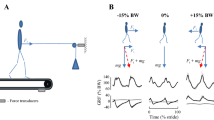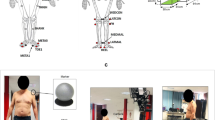Summary
Transversal torque between the stance leg and the ground was measured in 169 test persons with normal gait (91 women, 78 men; ages 15–79 years) using three-dimensional force plates. Taking the average of six to ten single steps produces reproducible person- and group-specific data. This permits the isolation and study of individual solutions to specific problems of locomotion, so-called gait mechanisms. The relatively great torque during the double-stance phase is caused mainly by the medially directed, short-term impact peak at heel strike, with the stride length as lever arm. Double-stance torque is therefore determined by motion dynamics and does not help in understanding individual gait mechanisms. Torque measured during the single-stance phase is, in comparison, rather small and is interindividually relatively variable. Experimentally measured torque is considered in terms of various hypotheses concerning the creation of torque in the human gait. Men obviously tend, for reasons of equilibrium and stability, to compensate the various torques. Better than the more known vertical, sagittal, and frontal force components, the remaining torque represents the individual problem solution and therefore permits the study of specific gait mechanisms, both physiological and pathological. Using the characteristic gait of patients with hemiplegia as an example, it is shown that pathological torque observed systematically on the nonaffected side in such patients is a quantitative measure of the trunk rotation necessary to move the plegic side forward. Measurement of this torque therefore permits precise determination of the degree of damage, as well as quantitative control and objective documentation of the rehabilitation progress.
Similar content being viewed by others
References
Chao EY, Laughman RK, Schneider E, Stauffer RN (1983) Normative data of knee joint motion and ground reaction forces in adult level walking. J Biomech 16:219–233
Inman VT (1966) Human locomotion. Can Med Assoc J 94:1047–1054
Kistler AG (1979) tOperating and service instructions for force plate type 9281B:13–15
Saunders M, Inman VT, Eberhart HD (1953) The major determinants in normal and pathological gait. J Bone Joint Surg [Am] 35:543–558
Stuessi E, Gerber H, Luethi S, Debrunner H, Senn E (1987) Analysis of the double stride in walking. In: Jonsson B (ed) Biomechanik X-A. Human Kinetics, Champaign, pp 381–386
Author information
Authors and Affiliations
Additional information
Dedicated to Prof. Dr. N. Zöllner on the occasion of his 70th birthday
Rights and permissions
About this article
Cite this article
Seichert, N., Senn, E. Clinical meaning of the torque between stance leg and ground for the analysis of gait mechanism. Clin Investig 71, 214–220 (1993). https://doi.org/10.1007/BF00180104
Received:
Revised:
Accepted:
Issue Date:
DOI: https://doi.org/10.1007/BF00180104




